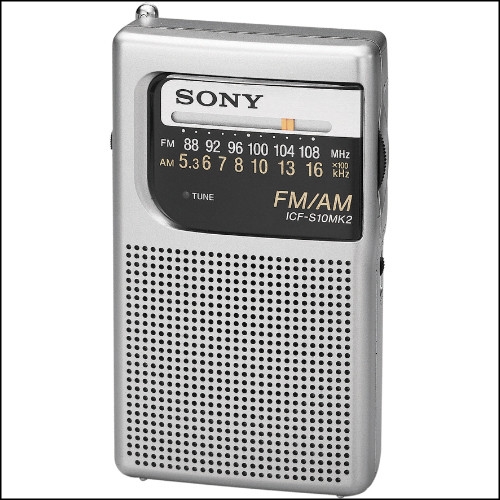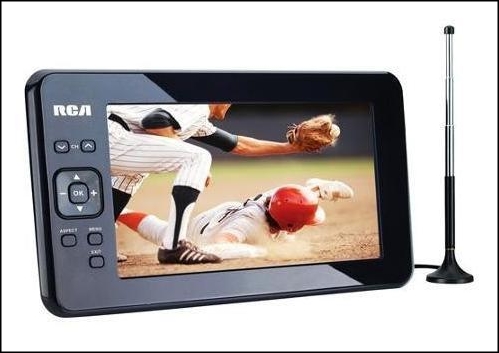There is a couple of items that we used and abused with glee and delivered. Boredom and lack of information are annoying at best and at worse can lead to desperation and stupid moves. Being able to get communications and even a bit of entertainment helps a lot. Both items are no longer being produced, but modern versions are available.
First, this AM/FM radio.
This is the model we had for many years now (since 2012 to be exact). I usually do not buy Sony because they charge you extra just for the name. But this one was priced around $10 in some flash sale of sorts and I snatched it for the wife who wanted something in her bathroom for the morning beautification ritual and to be small so it would not clutter her counter and a 4.5″ x 2.5″ x 1″ it does not get any more unobtrusive.
Next was this portable Digital TV.
Already a veteran of Katrina and Wilma. It is battery-powered, it can be plugged to your car’s lighter socket and to regular 120 AC. It was a substitute to the old analog Black & White AM/FM 5.5″ TV you could find in every store in South Florida for under $20 and even under $10 if you were attentive.
Unfortunately, the new portable digital TVs are not that cheap. Ours I found on sale at a Walgreens for the low-low price of $69.99 and you will find them in Amazon higher. The great thing about this little sucker is the external antenna that is connected to the TV via a coaxial input. The little antenna will help capture nearby stations, but I plugged an old inside-the-house antenna and I was getting stations from 2 counties away(I did add the aluminum foil bunny ears and they worked !)
I almost forgot: It comes with a remote and fully charged and not played with much it should give you about 90 minutes of play time. When the battery ran out, it was either charged via one of the cars or with its wall plug connected to the generator.
Now, these are not items to have on droning in the background 24/7 just to keep you company. You use them to give you a temporary respite and to be informed. TV and radio stations(if operative) will give you updates at the top and bottom of the hour and that is when you should tune. Saving an important event happening or a scheduled announcement, you should only tune at those times and shut off when the announcers become repetitive. Remember, you need to conserve resources.
The TV is back in the closet where it had been since Wilma. The radio is back on the bathroom counter. Both have outlasted “normal” devices: I had two iPods die on me plus we are changing our TV come Christmas since it suddenly developed a weird shadow on the screen that is annoying as hell.
You will learn to have to do with a bunch less when things go to the crapper. But you can mitigate your exposure yo hellish boredom if you are smart about it.
PS: Dead Tree Books do not need recharging or alkaline batteries.



Don’t know if you’ve hit this yet or not, but I’ve developed a fondness for this kind of manual can opener:
https://www.amazon.com/Japanese-Can-Opener-Ganji-Kankiri/dp/B001TV6A7G/ref=sr_1_1?ie=UTF8&qid=1507116521&sr=8-1&keywords=japanese+can+opener
Cheap at $8 each, no moving parts, heavy-gauge steel, and easy to use.
Those are good! Pretty much all variations of the P-51 can opener for home use are great.
I would love to see a digital TV that would work with regular batteries. These new ones are piece of shit. I have two and since they are rather old, they batteries do not last near the 90 minutes they are supposed to give you.
I would add another item, takes a little work, but a 2-meter (VHF-FM) amateur radio may be a good investment. A Technician class license allows you operate on assigned frequencies above 30 MHz (including VHF and UHF bands). Take a written test, file the paperwork and your done. Radios can be expensive (although Amazon has one for approx $25. No recommendation as I haven’t used it). Advantages: communication with emergency services with out going through (overloaded) cell service, most allow you to monitor police/fire/EMS channels (may be of limited utility if public service frequencies are encrypted), monitoring amateur radio emergency nets gives you a better picture of what’s happening where. Perhaps the best advantage: expanding your circle of friends and a built in support network.
Good advice, with one caution: VHF and above is quite short range. Normally repeaters are used to extend the range, but those suffer from the same sort of limitations that cellular base stations do. Lots of ham radio repeaters have some sort of standby power; it’s not clear to me that this will last across long power outages.
HF radio is not as easy to use but has no external dependencies. If you have a transceiver, power for it, and an antenna (which often is just a suitable length of wire) you can communicate all around the country, and indeed all around the world.
Along the same lines, if I were considering just a receiver I’d think about a general coverage receiver. Hams know the high grade models, but a number of makers like Kenwood and Icom make less fancy models at pretty modest prices. Those cover the AM and FM broadcast bands, but also lots more: short wave broadcast, shortwave ham bands, all manner of utilities like aviation, VHF ham, VHF public service, VHF aviation, you name it. Being able to listen to that wide a range of communication activities is potentially very helpful. (It’s also fun to do before the emergency hits.) And if all you do is listen, you don’t need a license (in the USA, that is).